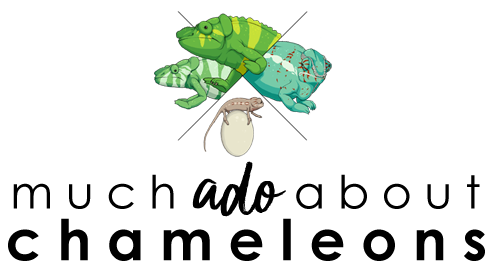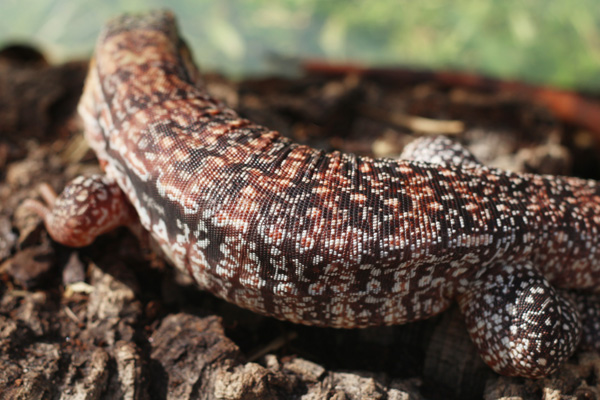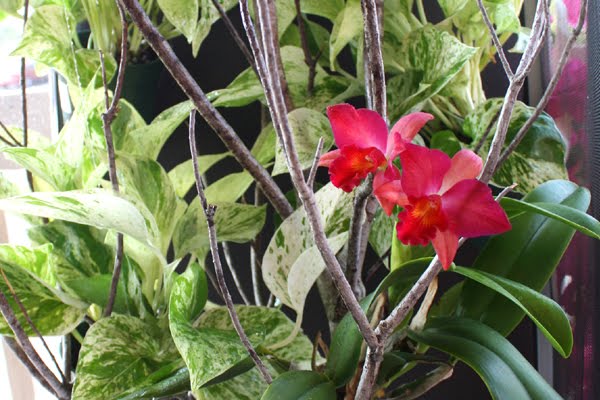This is my opinion on these matters.
I'm a huge fan of natural elements in cages - I think that it usually (not always, but usually) creates an environment that is better fitted to the animal, requires less work to keep this environment suitable, and stimulates the animal to engage in its normal and natural behaviors. We forget that our reptiles, whether they are snakes, geckos, or chameleons, still need daily stimulation in their environment to fend off boredom just like any other animal. And just like zoos make enclosures that let climbing animals climb, and burrowing animals to burrow, so should we.
I post photos of my chameleon cages all the time and you may have noticed that I don't use any substrate on the bottom. What gives, Olimpia? I know what you're thinking, it seems hypocritical. But because I use screen cages it's not practical to keep any substrate on the bottom, and since I mist a lot I have to make sure I drain away water efficiently (especially while I rent). However, I never bother to cover my plant pots with rocks to no one can get to the soil and I don't worry about my girls eating their laying bin medium when they lay. Additionally, all the geckos I do keep all live on fully planted, naturalistic enclosures.
The fact is that a healthy, well kept and well hydrated animal is probably not going to have problems passing a mouthful of soft, particulate substrate (like organic soil, sand, etc.)
I've volunteered with vets for over a decade, and I can tell you can whenever there was an impaction case it was always a reptile that wasn't properly hydrated or cared for (poor body weight, poor general health, bad enclosure, etc.) and just didn't have the ability to pass it. Additionally, bad supplementation will also play a role - poor calcium levels, for example, prevent the intestines (like all muscles) to contract properly, so it will be much harder for a gecko with a bad calcium deficiency to move anything through the GI tract well.
Above is my communal African fat-tailed gecko tank, with my three girls, before I changed it. I used a mix of organic top soil and peatmoss as the substrate, and planted a series of live plants around their various log hides. I've always kept my geckos in naturalistic terrariums such as this one and have yet to have a problem. I do free-range crickets in these tanks (I am trying to stimulate them with natural behaviors, such as searching for and hunting down their food), only bowl-feed worms, and always have a water bowl full of clean water.
Additionally, a set-up like this encourages them to do what these terrestrial geckos do best - dig! So every time I lift up their hide logs I find a different series of tunnels and burrows that they've made in their warm hides. I've never had obese geckos either, which seems a common problem with other people who keep them in plastic tubs with no chance for exercise or stimulation.
What you SHOULD avoid is substrate that is easy to swallow but hard to pass,
such as wood/bark chips, tiny gravel, etc. And products like Calci-sand, which clumps.
Above is another gecko tank I had, using a much less tropical theme. All the rocks, sticks, leaves, and logs were from outside - which brings me to another fear that people have. And that's a fear of using natural elements from outside. It's totally ok to go out and cut some branches for your cages. As long as the tree is a safe, non-toxic one, and it's not sprayed for anything, it will be safe. I usually only rinse my branches but you can bake them in the oven or soak them in warm water and bleach until you are satisfied that they aren't going to pass anything over to your pets.
But I always encourage new keepers to look into creating a more natural home for their pets, whether they are ball pythons, bearded dragons, or leopard geckos. Because a plastic tub in a space-efficient rack system seems like a very appealing idea, even if you aren't a big-time breeder, but your animals aren't going to be any happier or healthier for it, in my opinion. Sterile, plastic enclosures are for lab mice, not for your personal pets.














It is very delicious food. I want to do it. And if anyone wants to cook this can be viewed on the web at all.
ReplyDeletegclub
definately enjoy every little bit of it and I have you bookmarked to check out new stuff of your blog a must read blog! avis france pac environnement isolation
ReplyDeleteเล่นเกม สล็อต แจกเครดิตฟรี โบนัสเพียบ slot online
ReplyDeletehttps://www.live22easy.com/
Привет, подружки! Если еще не определились, то я окрашивала волосы здесь https://diamondbeauty.ru/. Отлично все сделали, очень довольна! И недорого! Очень рекомендую!
ReplyDeleteДобрый вечер! Замечательная запись. Благодарю за публикацию. Интересные посты об окнах из сосны https://svoknavdnh.wordpress.com/. Также рекомендую этот сайт: домостроительные статьи смотри на этом ресурсе., Дерево-алюминиевые евроокна из дуба из дуба в стандартные дома, Дешевые деревянные окна и балконная дверь из сосны, подоконники из лиственницы, Дерево-алюминиевые окна из дуба из дуба по серии дома
ReplyDelete